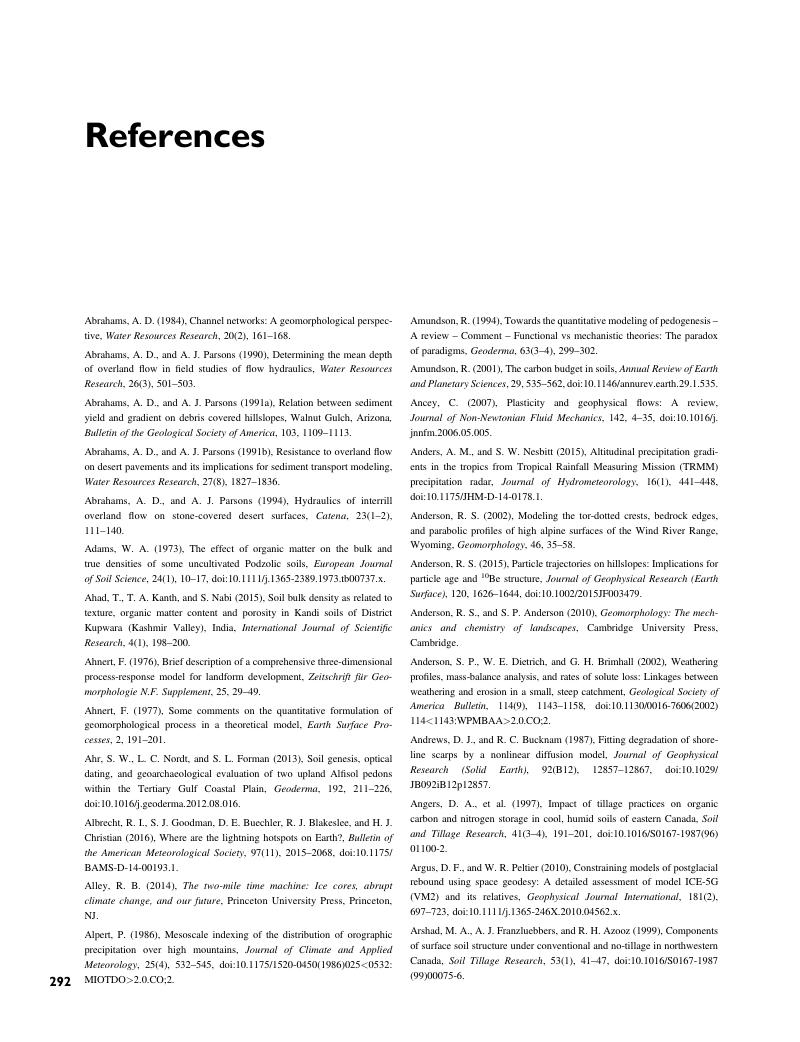Book contents
- Principles of Soilscape and Landscape Evolution
- Reviews
- Principles of Soilscape and Landscape Evolution
- Copyright page
- Contents
- Preface
- 1 Introduction
- 2 Constructing a Landscape Evolution Model – Basic Concepts
- 3 A Brief Hydrology and Geomorphology Primer
- 4 Erosion and Other Water-Driven Processes
- 5 Soils: Constructing a Soilscape Evolution Model – Basic Concepts
- 6 Soils: Soil Depth
- 7 Soils: Physical Weathering and Soil Particle Fragmentation
- 8 Soils: Chemical Weathering
- 9 Soils: Slow Soil Flow and Creep
- 10 Soils: Colloids and Soil Organic Carbon
- 11 Soils: Constructing a Soilscape Evolution Model – Details and Examples
- 12 Tectonics and Geology
- 13 High-Slope Gravity Processes
- 14 Vegetation and Wildfire
- 15 Constructing a Landscape Evolution Model – Details
- 16 Examples of Landscape Evolution Modelling and Final Thoughts
- References
- Index
- References
References
Published online by Cambridge University Press: 23 February 2018
- Principles of Soilscape and Landscape Evolution
- Reviews
- Principles of Soilscape and Landscape Evolution
- Copyright page
- Contents
- Preface
- 1 Introduction
- 2 Constructing a Landscape Evolution Model – Basic Concepts
- 3 A Brief Hydrology and Geomorphology Primer
- 4 Erosion and Other Water-Driven Processes
- 5 Soils: Constructing a Soilscape Evolution Model – Basic Concepts
- 6 Soils: Soil Depth
- 7 Soils: Physical Weathering and Soil Particle Fragmentation
- 8 Soils: Chemical Weathering
- 9 Soils: Slow Soil Flow and Creep
- 10 Soils: Colloids and Soil Organic Carbon
- 11 Soils: Constructing a Soilscape Evolution Model – Details and Examples
- 12 Tectonics and Geology
- 13 High-Slope Gravity Processes
- 14 Vegetation and Wildfire
- 15 Constructing a Landscape Evolution Model – Details
- 16 Examples of Landscape Evolution Modelling and Final Thoughts
- References
- Index
- References
Summary

- Type
- Chapter
- Information
- Principles of Soilscape and Landscape Evolution , pp. 292 - 319Publisher: Cambridge University PressPrint publication year: 2018

